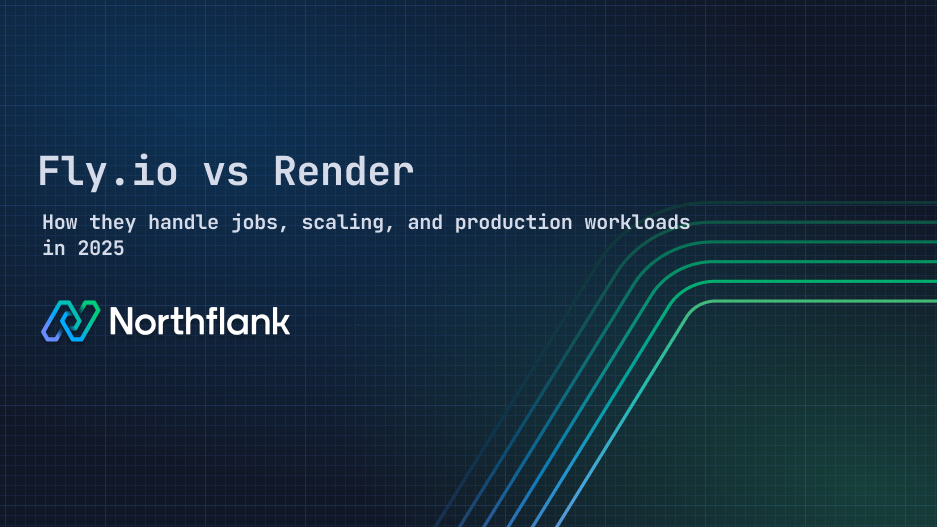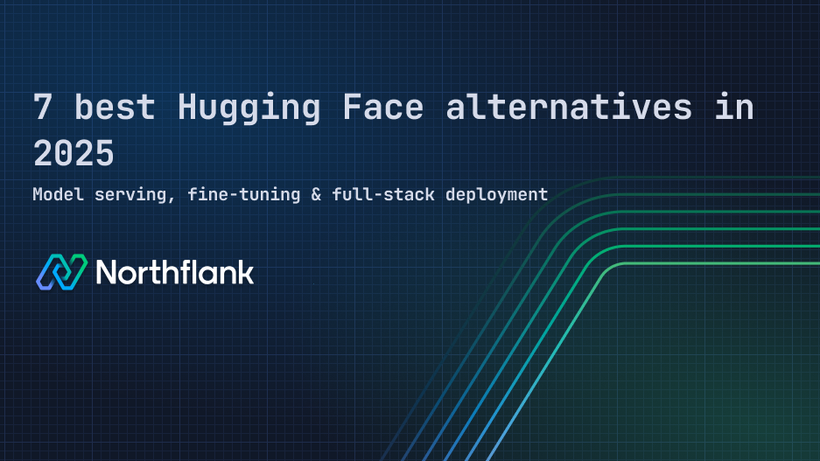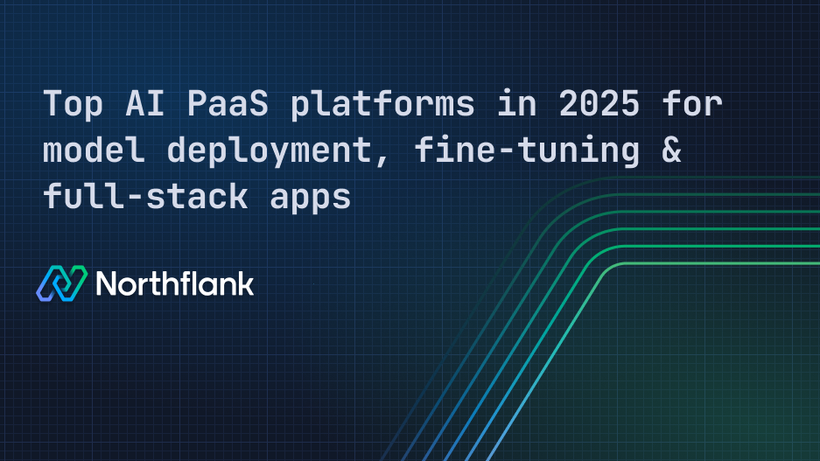

Fly.io vs Render: How they handle jobs, scaling, and production workloads in 2025
“Fly seems incredibly cheap in the calculator, but in our experience a Fly shared-cpu-1x machine is far less capable than other shared 1vCPU setups like a Render Standard instance or a Heroku Std-1x dyno.” ~ Someone on Reddit comparing Fly.io vs Render
That’s one of the many performance differences developers have called out when working with these platforms.
Have you had to compare throughput or reliability across Fly.io and Render? It doesn’t take long to see that, beyond onboarding speed, they take very different approaches to how applications are deployed, scaled, and managed in production.
This comparison focuses on how each platform handles production workloads, specifically in areas like:
- How job execution is structured and isolated
- How predictable resource access is across different service types
- How much configuration is needed to keep apps running over time
- And how much control you’re given when you need to scale or optimize
I reviewed both platforms from a technical perspective, verified their latest updates, and focused entirely on how they operate in production environments.
Let’s look at the differences that show up once your service is deployed, to help you decide which platform is a better fit for how you build and run applications.
Let’s start with a technical comparison of how Fly.io and Render handle the basics once your app is up and running.
If you're deploying production workloads and care about things like job orchestration, regional scaling, or how services behave when they reach usage limits, this breakdown gives you a side-by-side view of what to expect from each platform.
| Feature | Fly.io | Render |
|---|---|---|
| App lifecycle | Apps can scale to zero by stopping or suspending Machines using fly.toml settings like auto_stop_machines and min_machines_running.You control scale and region through CLI or API. There’s no enforced hard limit on app concurrency, but tuning soft and hard concurrency thresholds is critical for managing load and latency. | Free-tier services are suspended after 750 instance hours per month unless upgraded. Services on paid plans support scaling across instances, but Render does not scale services to zero automatically. Free services don’t support autoscaling or persistent disk and may be restarted by Render at any time. |
| Worker and cron support | You define background workers and cron jobs as separate process groups in your fly.toml file.Each group runs in its own VM, so you can scale job workloads independently. Cron jobs typically use a containerized scheduler like supercronic, and queue workers require explicit commands.There’s no built-in scheduler, the flexibility is there, but you handle setup, scaling, and deployment. | First-class support for background workers and cron jobs. You can create both directly in the dashboard, no need for custom process groups or container logic. Cron jobs support schedule expressions, commands, environment variables, and manual triggering. Background workers run continuously and are ideal for queue-based workloads. |
| Pricing behavior | Usage-based billing for compute (per second), storage (per hour), and bandwidth. Prices vary by region and instance type. Reserved blocks offer 40% discounts. Data egress and cross-region transfer are billed separately, with granular rates for newer orgs. GPU, static IPs, and SSL certs have separate costs. | Fixed monthly render hosting pricing per user, plus compute costs. Each plan includes a bandwidth allowance (e.g., 500 GB for Pro, 1 TB for Org). You pay for provisioned resources with transparent per-second billing. Staying within plan limits keeps costs predictable, extra usage may require upgrading to a higher tier. |
| Databases | Fly.io provides Postgres clusters via Fly Postgres, which is not a managed service. You control replication, failover, and HA setups across regions. Supports multi-region read replicas and rerouting writes using fly-replay.Also offers Upstash for Redis, fully managed with global read replicas and fixed or usage-based pricing. You manage both through the Fly CLI. | Fully managed Postgres with high availability, read replicas, and predictable pricing. Render provides managed PostgreSQL with high availability, daily backups, read replicas, and private networking. You can monitor metrics, scale vertically, and restrict access by IP. Storage can be increased without downtime, and each instance can host multiple databases. Starts at $6/month with a free tier. |
| Scaling options | Supports both metric-based autoscaling and Fly Proxy’s autostart/autostop, which spins Machines up and down based on traffic. You can scale on custom metrics like queue depth or Temporal workflows. Built-in support for multi-region deployments lets you run apps close to users and replay writes to the primary region. | Supports manual and autoscaling based on CPU or memory usage. Autoscaling is available on paid plans only. No native support for multi-region services or global load balancing, each service is tied to a single region. |
| Team collaboration | Team management is handled at the organization level. There's no per-app access control, all members of an org have access to all apps in that org. For more granular permissions, you’ll need to create and manage separate orgs. | Role-based access per service. Teams can manage permissions at the workspace level, with audit logs and user roles available on higher-tier plans. Admins can invite users, manage billing, and assign roles. Developers have limited access to protected environments. Hobby workspaces don’t support team members. |
Here’s how many developers think about the choice:
“Some developers choose Fly.io for fine-grained control over VM types, region placement, and custom autoscaling. Others prefer Render because it abstracts away infrastructure, handling things like build pipelines, background workers, and TLS automatically.”
The table above shows how Fly.io and Render compare on the surface, from autoscaling behavior to team roles. But beyond the feature list, Fly.io takes a different approach to developer control.

While Render gives you a more guided path with built-in defaults, Fly.io appeals to teams that want to choose where their services run, manage deployments as code, and scale apps globally on their own terms. If you care about regional performance or want low-latency setups at the edge, Fly.io gives you more flexibility, as long as you’re prepared to manage it.
If you’ve ever searched for “what is Fly.io”, it’s a platform that lets you run containers globally without managing infrastructure directly. It’s built for teams that want precise control over regions, scaling, and services, often writing configuration instead of clicking through dashboards.
- You define services in a
fly.tomlfile, including scaling behavior, regions, ports, and process groups. - Deployments are container-based but run inside Firecracker VMs. You’re not limited to pre-set types like "Worker" or "Cron Job", you define them manually.
- Fly.io is popular in the Elixir and Phoenix ecosystem, where fast boot times, distributed messaging, and low-latency edge setups matter.
- Billing is usage-based: compute per second, volumes per hour, and bandwidth per region.
- Built-in PostgreSQL hosting is available, with support for global replication and regional read replicas.
- You can deploy apps close to users in over 20 global regions, with better latency than US-only platforms.
Now that you’ve seen how Fly.io is structured and who it’s built for, let’s look at what that control gives you in practice.
Fly.io exposes nearly every layer of your app’s runtime, which is useful if you want infrastructure that adapts to how your app works.
- You can deploy to specific regions and assign different process groups (web, worker, etc.) to different locations.
- Scaling is manual unless you configure autoscaling, either based on traffic via Fly Proxy or using metrics like CPU or queue depth.
- Apps can scale to zero, which helps reduce cost for staging environments or internal tools.
- You configure volumes, networking (including private WireGuard networks), and service discovery through the CLI or API.
- Deployments behave like lightweight VM orchestration, and nearly everything is scriptable.
- Developers often choose Fly.io for low-latency routing and global deployment control, especially in communities like Elixir, Rails, and DevOps.
Once you step beyond initial setup, Fly.io assumes you’re comfortable owning the details. The platform exposes a lot, but that also means doing more configuration yourself.
- Background jobs and cron tasks aren’t native features. You define them as separate
processesin yourfly.tomland use tools likesupercronicor custom schedulers to manage execution. - Trial environments are limited. The $5 free credit typically covers only minimal usage (e.g. a single shared-CPU VM), and services are halted once the credit runs out unless billing is added.
- You’ll handle VM orchestration manually: configuring volume mounts, setting concurrency thresholds, tuning health checks, and managing failover or region affinity via CLI or API.
- There’s no managed Redis, MongoDB, or external database marketplace. You either self-host these inside your org as containers or connect to third-party services.
- Multi-region setups introduce cost variables, like cross-region volume replication or latency-driven traffic spikes, that require monitoring to avoid unexpected charges.
- Fly.io pricing is based on granular usage, per-second compute, per-hour storage, and bandwidth per region. That level of control works well for tuned setups, but costs can spike if services aren’t tightly managed.
Read more: Top 6 Fly.io alternatives in 2025
If Fly.io gives you full control over how services run, Render takes the opposite path, it handles most of the infrastructure decisions for you.

You don’t need to configure regions, process groups, or schedulers. Instead, you define your app in the dashboard or via Git, and Render takes care of provisioning services like web apps, background workers, cron jobs, and databases using built-in defaults.
It’s a good fit if you’d rather spend less time managing containers or infrastructure logic and more time shipping. Tasks like setting up deployments, logs, health checks, and access control are already handled, with no need to write config files or define service behavior manually.
What is Render? It’s a PaaS designed to abstract the infrastructure layer while still supporting full-stack applications. You define your services, web apps, background workers, cron jobs, and databases, and Render provisions and connects them automatically.
- You can deploy from Git without writing a Dockerfile. Custom Docker builds are supported if your setup requires them.
- Background workers and cron jobs are defined as first-class service types. You don’t need to create separate containers or define process groups manually.
- Built-in CI/CD, deployment logs, health checks, and environment-level access controls are included (no additional setup needed).
- Pricing is based on plan and instance type. There’s no per-second or per-region billing to monitor.
- If your team doesn’t want to manage Docker, YAML, or cloud regions, Render lets you skip those layers and focus on application logic.
Render provides built-in abstractions for jobs, logging, and monitoring, so you don’t have to configure them yourself. Once you define a service, Render handles provisioning, deployment, and runtime behavior using defaults that are consistent across environments.
- You define cron jobs and background workers directly in the dashboard or via a
render.yamlfile. No need to manage schedulers or run additional containers. - Each service includes real-time logs, deploy history, and basic failure alerts by default.
- Free-tier services support always-on behavior (up to 750 instance hours/month), with autosuspend only when usage limits are exceeded.
- Billing is tied to instance size and plan. Render pricing rules are clearly visible in the UI and docs.
- This setup works well if you’re building production apps without a dedicated infrastructure team, and want services to be preconfigured with sane defaults.
The structured environment that makes Render easy to start with also introduces constraints as your infrastructure needs grow. If you need region-level control, usage-based cost scaling, or database flexibility, these limitations can affect how far you can scale on the platform.
- Pricing is flat per instance and user, regardless of traffic. This works well at steady usage but provides no cost advantage for idle or low-traffic services.
- Services are pinned to one of five fixed regions. There’s no support for global load balancing or deploying the same service across multiple regions.
- Only PostgreSQL and Redis are available as managed databases. You’ll need to self-host other options like MongoDB or MySQL.
- Team billing is based on seat count, not usage. Adding developers increases monthly costs even if resource usage stays constant.
- Infrastructure-level controls like per-region autoscaling, private networking, or traffic shaping are not exposed, making it harder to support complex or multi-region setups.
If these limits are blockers for you, check out 7 Best Render alternatives for simple app hosting in 2025
Fly.io gives you low-level control, but expects you to manage most of the stack yourself. Render handles setup and deployment for you, but trades off flexibility, especially if you need fine-grained control over regions, workloads, or team structures.
If you're comparing Render vs Fly.io and noticing limitations in how they support production workloads, that’s a common experience for teams building beyond basic deployments.
If you're looking for a platform that includes built-in job orchestration, production-ready defaults, and support for advanced workloads, without locking you into a single region or asking you to build everything from scratch, Northflank fills that gap.
Let’s quickly see what that looks like in practice:
Northflank supports Bring Your Own Cloud (BYOC), so you can run services inside your own AWS, GCP, or Azure accounts while managing deployments through Northflank’s dashboard, API, or CI/CD integrations. You keep full control over where your infrastructure runs, whether that’s for compliance, cost management, or data residency.
Here's how Northflank integrates with your own cloud, while keeping control in your hands through the dashboard, CLI, or API:
 Deploy in your own cloud with full control (use Northflank’s UI, CLI, or API to manage services across AWS, GCP, Azure, and more)
Deploy in your own cloud with full control (use Northflank’s UI, CLI, or API to manage services across AWS, GCP, Azure, and more)
Background workers and cron tasks are first-class service types in Northflank. You don’t need to spin up extra containers or rely on external schedulers, you can define, run, and scale jobs from the UI or API.
See how scheduled jobs are managed directly in the Northflank dashboard, with visibility into cron schedules, job history, and associated commits:
 Managing a scheduled cron job in Northflank’s UI (with commit history, recent job runs, and job metadata all visible in one place)
Managing a scheduled cron job in Northflank’s UI (with commit history, recent job runs, and job metadata all visible in one place)
Northflank includes structured logs, audit trails, secret management, health checks, and preview environments as part of its core platform. You get the production-ready defaults most teams need, without having to configure each one from scratch.
Here’s how a preview environment template is defined in Northflank, from Git triggers to automated lifecycle settings:
 Create a structured preview environment with Git triggers, naming rules, and lifecycle automation.
Create a structured preview environment with Git triggers, naming rules, and lifecycle automation.
You get role-based access control, billing visibility, usage analytics, and project-level isolation, so each team or client can manage their services independently. From growing startups to enterprises with strict controls, Northflank supports multi-user collaboration and access governance out of the box.
Here’s what it looks like to configure access roles and restrict permissions by project and team in Northflank:
 Set custom access roles across teams and projects with Northflank’s role-based access control (RBAC)
Set custom access roles across teams and projects with Northflank’s role-based access control (RBAC)
With stack templates, you can deploy services like GrowthBook, PostHog, Temporal, or vLLM in a few clicks, with sensible defaults already configured for networking, storage, and scaling.
Here’s how Northflank helps you skip boilerplate setup with production-ready stack templates:
 Deploy GrowthBook, Temporal, and other tools with one click using Northflank’s built-in stack templates
Deploy GrowthBook, Temporal, and other tools with one click using Northflank’s built-in stack templates
Northflank supports GPU-based workloads, so you can run services like vLLM or TGI on infrastructure with NVIDIA GPUs. You can choose from a range of models (including H100, A100, T4, and others), and deploy in your own cloud or on Northflank-managed clusters.
- You can provision GPU nodes on AWS, GCP, Azure, Oracle, or Civo.
- Support is available for time slicing and NVIDIA MIG, so resources can be partitioned across workloads.
- Multiple GPU types are supported, including both NVIDIA and AMD models.
- Access is self-service but requires a short onboarding step, you define your use case and preferred provider here.
Here’s a view of how GPU node pools are configured directly in the Northflank UI:
 Provision GPU node pools with autoscaling and support for time slicing (shown here with NVIDIA T4, A100, and H100 across AWS zones)
Provision GPU node pools with autoscaling and support for time slicing (shown here with NVIDIA T4, A100, and H100 across AWS zones)
You can do everything programmatically with the Northflank API and CLI, from creating projects and deployments to managing secrets, databases, builds, and more. All core functionality available in the UI can also be handled via API or command line, so you’re free to automate workflows or build your own platform interface.
Northflank’s CLI and REST API both support full context switching, Git integration, granular permissions, and resource creation with structured definitions, which are ideal for infrastructure-as-code and CI/CD pipelines.
Set up access and permissions through the UI or script the same process via API or CLI, it’s the same flow underneath:
 Create API roles in the UI with scoped permissions and project restrictions (the same structure applies when defining roles programmatically)
Create API roles in the UI with scoped permissions and project restrictions (the same structure applies when defining roles programmatically)
Fly.io gives you low-level control with manual setup for regions, scaling, and job orchestration. Render handles those layers for you, but limits flexibility across regions and service types.
If you need support for background jobs, CI/CD, GPU workloads, or infrastructure-as-code, without giving up UI visibility or control over where your apps run, Northflank gives you that balance.

